Classic & Sportscar Magazine..
The following article by Paul Hardiman featured in the February 1999 edition
of Classic & Sportscar magazine and is reproduced by kind permission.
All text and images © Haymarket Specialist Publications Ltd. 1999. All
rights reserved
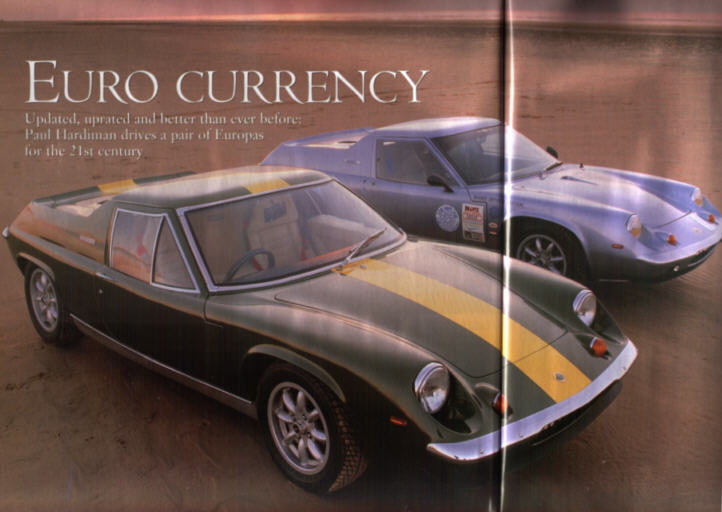 |
 o
this is what a grown-up Europa feels like. Pop the lightweight door and
crank your head to one side to slide sideways into the laid-back seat:
Europas are a struggle for anyone over 6ft to enter, but happily
tailor-made for a 5ft 8in 130lb Hardiman. Once comfortably inserted and
strapped in with the racing harness, '70s Oatmeal vinyl overwhelms for
this car's original features have been beautifully preserved. The wheel is
high, and quite a reach away, like all Europas, a product of the lay-down
position. o
this is what a grown-up Europa feels like. Pop the lightweight door and
crank your head to one side to slide sideways into the laid-back seat:
Europas are a struggle for anyone over 6ft to enter, but happily
tailor-made for a 5ft 8in 130lb Hardiman. Once comfortably inserted and
strapped in with the racing harness, '70s Oatmeal vinyl overwhelms for
this car's original features have been beautifully preserved. The wheel is
high, and quite a reach away, like all Europas, a product of the lay-down
position.
Yet something's different when you turn the key: gone is the Lotus/Ford
twin-cam's raucous clatter; instead, there's a clipped, gruff exhaust
bark, settling to a businesslike burble that belongs to a later era. Notch
the lever into first slot in its tight gate, take off and discover plenty
of torque - and guess what? This one revs happily beyond 7000 real rpm .
As it reels in the horizon you're aware of being planted more firmly on
the road than in any Europa ever before, stability that gives you the
confidence to explore its gorgeously elastic powerband. It's not about
weight - although this one is denser than most Europas, that's for sure.
It's about authority and in this the tiny glassfibre sports-racer behaves
like a baby GT40, cleaving through the Lancashire lanes purposefully,
changing direction incisively and approaching other road users with
wolfish rapidity. It rolls a little, and there's just a trace of
understeer, but although it weighs just three quarters of a tonne, it
won't budge off line. The steering's sublime.
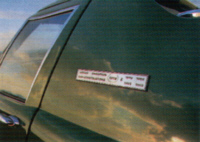 |
This car is not as it came
out of Hethel. It has been got at, massaged by people who know, love
and understand Europas.
When Chapman's mid-engined racer for the road came out in967,
there had been nothing quite like it before. Anyone raised on A60s -
or even the two-seat version, the MGB - could not have believed its
dynamics. A combination of light weight and simple suspension that
cheaply made the best use of the marginal rubber possessed it of
clinging properties bettered only by the wife in the Beatles'
Paperback whiter.
But, unless they are looked after, Europas can be fragile. One of
the first things to go off is the rear suspension, which relies on
the rubber gearbox mountings retaining their integrity to keep the
back wheels pointing where they're meant to be. A bad one defies the
Europa's raison d'etre - it does not want to go round corners very
well, and the men at Banks Service Station understand that score
implicitly. So when Nick Valery's Special, which he had owned from
new in 1973, got tired, he sent it up to Southport for rejuvenation.
Now, under its original body, it wears a new chassis with modern
twin cam power and all-round disc brakes, and into the original
interior air conditioning has cleverly been integrated, a home-made
system that Banks boss Richard Winter plumbed in himself from
proprietary bits. The chassis, or subframe as Richard prefers it, is
Banks' own made of welded small-section box tubes stiffened by
riveted and bonded panelling, and proper wishbone suspension at the
rear. you can have one too for£1580 plus VAT. |
| Badge is no idle boast; both
cars have new running gear |
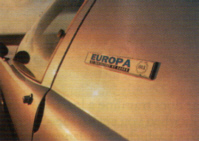 |
| 'With 208bhp, there's no doubt
this one will exceed 160mph. These cars are very slippery' |
|
|
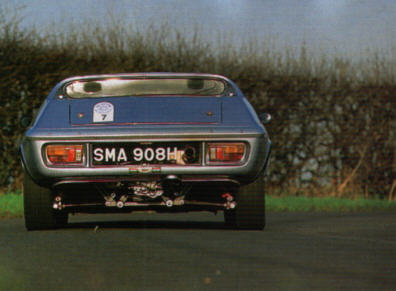
This is 'high'-suspension rally version. Light weight gives
sharp steering response and innate feeling of chuckability |
|
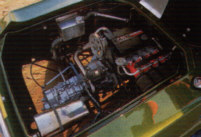 |
| Vaux is pop: 208bhp 16v 2-litre above, and 125bhp 8v
1600 |
|
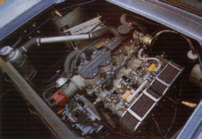 |
|
| This is a completely re-engineered car, not a
modified one. The 2-litre, 6-valve Vauxhall twin-cam runs fuel injection (MBE,
firing through Jenvey throttle body injectors), that Richard casually
mentions, throwaway: "We mapped it ourselves, using a PC." This stuff runs
far deeper than normal cottage industry fare, folks. It makes 208bhp at
8000rpm, and driving through a reversed Renault five speed transaxle from
the 18/Fuego series, it's geared for 70mph at peak revs. Richard has seen
more than that on a car similarly geared but propelled by 240bhp, so
there's no doubt this one will exceed 160: "It's a very slippery shape,
remember," he says. Despite the extra weight - 742kgs is quite heavy for a
Europa but quite understandable given the extra engine, soundproofing,
electric windows and air - 0-60mph comes in at just 4.9 secs. This car has
been very thoughtfully assembled. The gearchange has short, precise
throws, remarkable given there's six feet of linkage between you and the
'box. The tyres, 85/60x14 Hankooks, are an interesting choice: there's
huge grip but the soft sidewalls give a supple ride. The only failing of
the chassis/tyre combination is that the car does tramline a lot,
following imperfections in the road, especially when you get on the
anchors. You either hate or put up with this trait, which is not dangerous
but strangely endearing: I would rather keep it, along with the associate
lightning responses. There's no servo, which would rob pedal feel so the
brakes require a firm shove, and bias is adjustable via the discreet
knurled knob down by the steering column.
The road car, which has since returned to its owner in Tokyo, is a very
mature roadburner, discreet and deceptively effective cross country. But
with its maturity is a feeling that, however high its limits, it would not
tolerate liberties well. The silver rally car is completely different -
you really want to chuck it about. What's remarkable is that the two cars
do not differ massively in specification. And what's more remarkable is
that a Europa - any Europa could survive a tough, 10,000 kilometre road
rally.
|
|
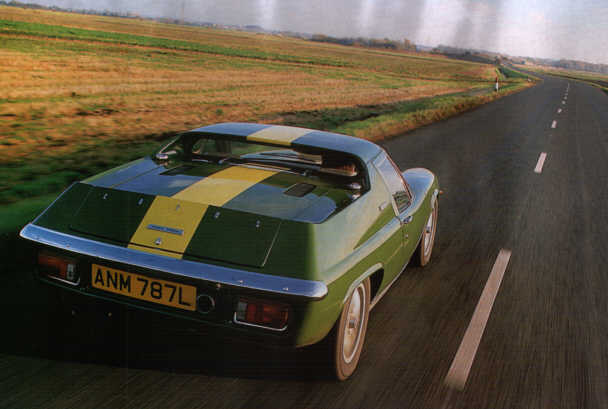 |
It depends how you build 'em. This one is made from the most appropriate
parts in the range, to do a specific job. It runs Banks' own chassis and a
lightweight Type 74 shell, a simpler engine, and it comes out at just
640kgs. Banks is now building racers down to 600kgs, which is Caterham
territory. This 1600 is powered by an eight-valve sohc lump from an Astra,
running a fast road cam and twin Weber 40s. It knocks out around 125 bhp -
and quite a bit less torque: you don't need much in such a lightweight. It
sits half an inch higher than the green car, but wears exactly the same
wheel and tyre equipment. And it's a whole lot livelier to drive, less
intimidating because it's not as quick: in fact, you can cane this one
everywhere and it's a hoot: 100 kgs has never made so much difference. |
|
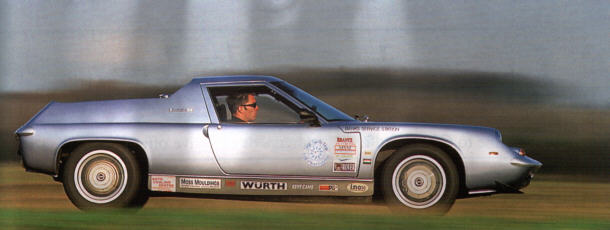 |
Road car retains complete, original oatmeal interior. Air
conditioning unobtrusive, and there's a discreet roll cage too
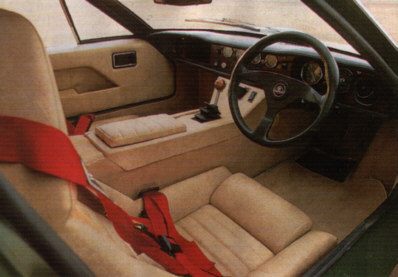 Most
of that comes from the lighter shell and engine, but soundproofing and
electric windows are absent - and the wheel seems higher because there's
much less seat padding or the 6ft 2in Winter wouldn't fit. Doors are from
an S1, which would not normally have opening windows, but on this one they
hinge slightly allowing a bit of a draught. More ventilation comes from
the sock filter buried in NACA scoop at the back of the bonnet, to deliver
air to the crew. One of the flaws of Chapman's original design was that
with the front full, cockpit ventilation was blanked off. There's a full
roll cage, and Richard found room for a Brantz tripmeter too. Most
of that comes from the lighter shell and engine, but soundproofing and
electric windows are absent - and the wheel seems higher because there's
much less seat padding or the 6ft 2in Winter wouldn't fit. Doors are from
an S1, which would not normally have opening windows, but on this one they
hinge slightly allowing a bit of a draught. More ventilation comes from
the sock filter buried in NACA scoop at the back of the bonnet, to deliver
air to the crew. One of the flaws of Chapman's original design was that
with the front full, cockpit ventilation was blanked off. There's a full
roll cage, and Richard found room for a Brantz tripmeter too.
It held together on 10,000 kilometres of tough, broken roads in north
Africa, on the 1997 Liege-Agadir-Liege rally: "Officially it was Tarmac,
but it didn't pan out quite like that," says Richard, remembering the
typical Moroccan roads. "We went through rivers up to the door handles and
mud up to the sills - that must have been one that was drying out. It
didn't begin well: I went off within 20 seconds of the start, at Spa,
after warning everyone to be careful on the dewy Tarmac after Eau Rouge.
I'd been off there on a bike a few years before, so I should have known
better."
Weight has a lot to answer for. Two cars, sisters so close in
specification: it's amazing they call feel so different.
|
|
Road car (left) feels more ponderous in corners,
thanks to extra 100kg. No more roll than 640 kgs car (right), though |
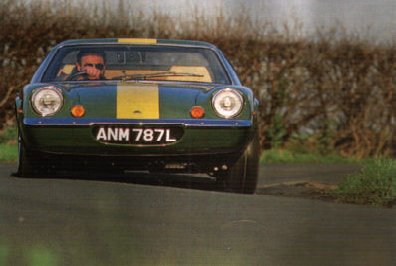 |
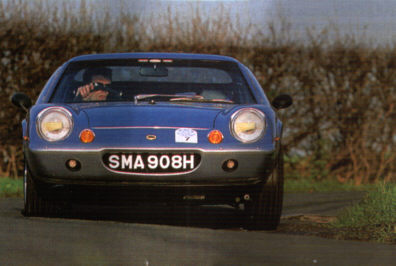 |
|
